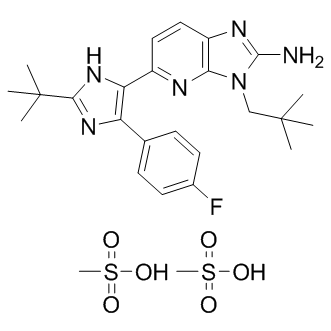| In Vivo: |
In LPS-induced mice, Ralimetinib dimesylate (LY2228820) effectively inhibits the formation of TNFα with a threshold minimum 50% effective dose (TMED50) less than 1 mg/kg. In a rat model of collagen-inducedarthritis (CIA), Ralimetinib dimesylate (LY2228820) displays potent effects on paw swelling, bone erosion, and cartilage destruction, with a threshold minimum 50% effective dose (TMED50)of 1.5 mg/kg[1]. Ralimetinib dimesylate (LY2228820) inhibits tumor phospho-MK2 in a dose-dependent manner (TED50=1.95 mg/kg, TED70=11.17 mg/kg) in mice implanted with B16-F10 melanoma. Ralimetinib dimesylate (LY2228820) inhibits MK2 phosphorylation: mouse in vivo TED50=1.01 mg/kg (compound exposure approximately 100 nM) and human ex vivo IC50=0.12 μM with either mouse or human PBMC[3]. |
| In Vitro: |
Ralimetinib dimesylate (LY2228820) inhibits p38α, as well as the level of phosphoMAPKAPK-2 (pMK2) in RAW 264.7 cells, with IC50 values of 7 nM and 34.3 nM, respectively. Furthermore, Ralimetinib dimesylate (LY2228820) inhibits lipopolysaccharide (LPS)-induced TNFα formation in murine peritoneal macrophages, with IC50 of 5.2 nM[1]. In multiple myeloma (MM) cells, including INA6, RPMI-8226, U266, and RPMI-Dox40, Ralimetinib dimesylate (LY2228820) (200 nM-800 nM) significantly blocks p38MAPK signaling, as revealed by its inhibition on phosphorylation of HSP27, a downstream target of p38MAPK, without affecting the expression level of HSP27. Ralimetinib dimesylate (LY2228820) (200 nM-400 nM) enhances bortezomib-induced cytotoxicity and apoptosis, but Ralimetinib dimesylate (LY2228820) alone doesn't inhibit the growth of MM.1S cells. Ralimetinib dimesylate (LY2228820) (200 nM-800 nM) also inhibits secretion of IL-6 and MIP-1α in long-term BM stromal cells (LT-BMSCs), BM mononuclear cells (BMMNCs), peripheral blood (PB) CD138+, CD138- or PB CD14+ cells. Ralimetinib dimesylate (LY2228820) (400 nM-800 nM) also blocks osteoclastogenesis from CD14+ cells[2]. |






















